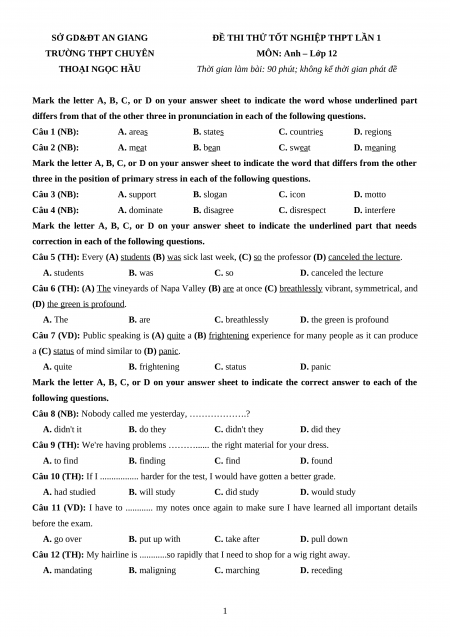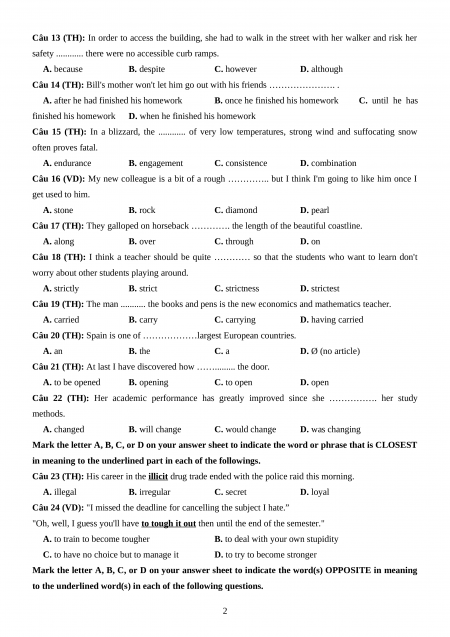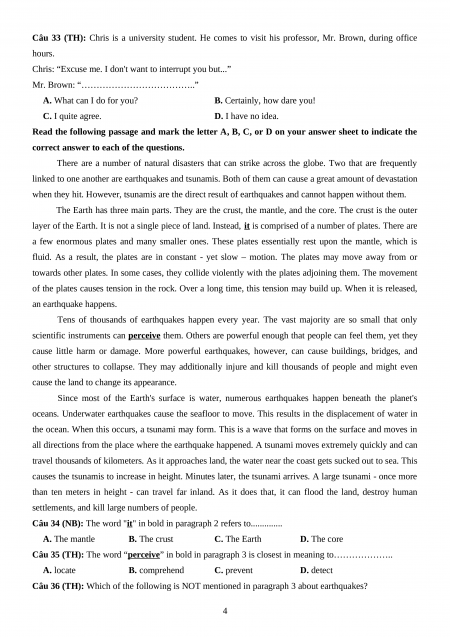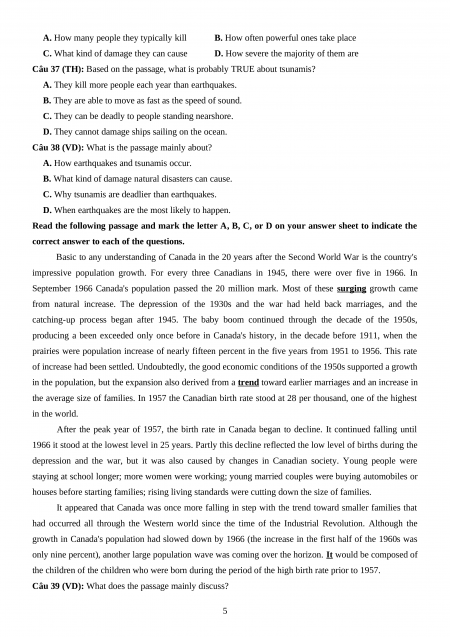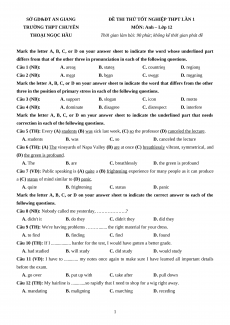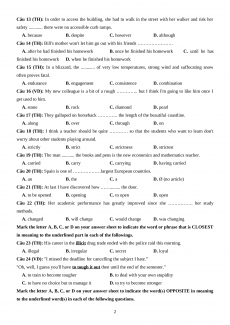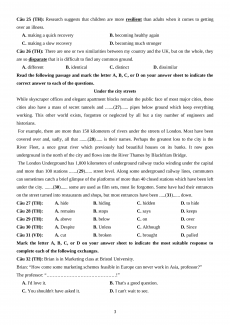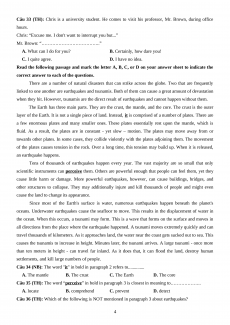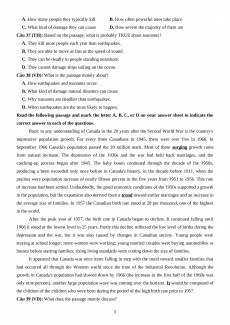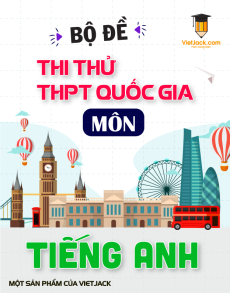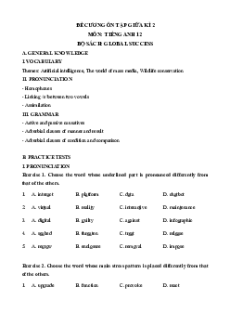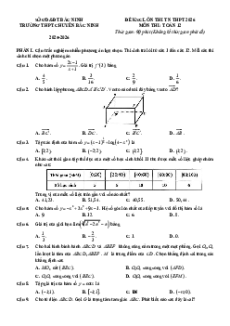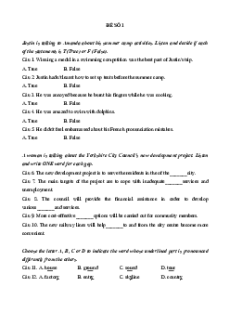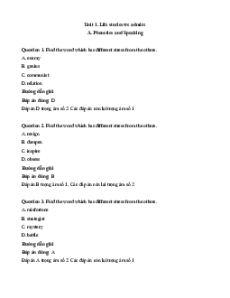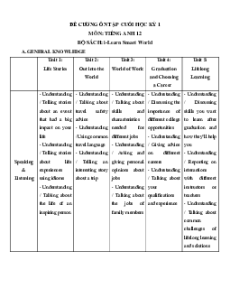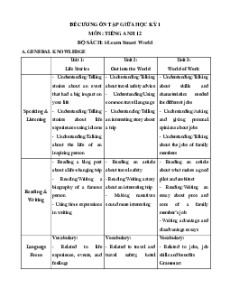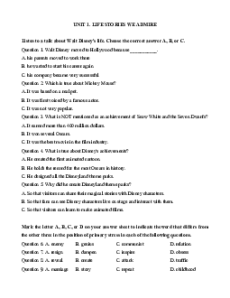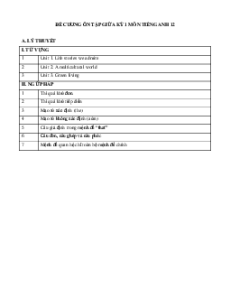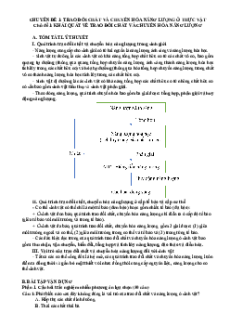SỞ GD&ĐT AN GIANG
ĐỀ THI THỬ TỐT NGHIỆP THPT LẦN 1 TRƯỜNG THPT CHUYÊN MÔN: Anh – Lớp 12 THOẠI NGỌC HẦU
Thời gian làm bài: 90 phút; không kể thời gian phát đề
Mark the letter A, B, C, or D on your answer sheet to indicate the word whose underlined part
differs from that of the other three in pronunciation in each of the following questions. Câu 1 (NB): A. areas B. states C. countries D. regions Câu 2 (NB): A. meat B. bean C. sweat D. meaning
Mark the letter A, B, C, or D on your answer sheet to indicate the word that differs from the other
three in the position of primary stress in each of the following questions. Câu 3 (NB): A. support B. slogan C. icon D. motto Câu 4 (NB): A. dominate B. disagree C. disrespect D. interfere
Mark the letter A, B, C, or D on your answer sheet to indicate the underlined part that needs
correction in each of the following questions.
Câu 5 (TH): Every (A) students (B) was sick last week, (C) so the professor (D) canceled the lecture. A. students B. was C. so
D. canceled the lecture
Câu 6 (TH): (A) The vineyards of Napa Valley (B) are at once (C) breathlessly vibrant, symmetrical, and
(D) the green is profound. A. The B. are C. breathlessly
D. the green is profound
Câu 7 (VD): Public speaking is (A) quite a (B) frightening experience for many people as it can produce
a (C) status of mind similar to (D) panic. A. quite B. frightening C. status D. panic
Mark the letter A, B, C, or D on your answer sheet to indicate the correct answer to each of the following questions.
Câu 8 (NB): Nobody called me yesterday, ……………….? A. didn't it B. do they C. didn't they D. did they
Câu 9 (TH): We're having problems ………...... the right material for your dress. A. to find B. finding C. find D. found
Câu 10 (TH): If I ................. harder for the test, I would have gotten a better grade. A. had studied B. will study C. did study D. would study
Câu 11 (VD): I have to ............ my notes once again to make sure I have learned all important details before the exam. A. go over B. put up with C. take after D. pull down
Câu 12 (TH): My hairline is ............so rapidly that I need to shop for a wig right away. A. mandating B. maligning C. marching D. receding 1
Câu 13 (TH): In order to access the building, she had to walk in the street with her walker and risk her
safety ............ there were no accessible curb ramps. A. because B. despite C. however D. although
Câu 14 (TH): Bill's mother won't let him go out with his friends …………………. .
A. after he had finished his homework
B. once he finished his homework C. until he has finished his homework
D. when he finished his homework
Câu 15 (TH): In a blizzard, the ............ of very low temperatures, strong wind and suffocating snow often proves fatal. A. endurance B. engagement C. consistence D. combination
Câu 16 (VD): My new colleague is a bit of a rough ………….. but I think I'm going to like him once I get used to him. A. stone B. rock C. diamond D. pearl
Câu 17 (TH): They galloped on horseback …………. the length of the beautiful coastline. A. along B. over C. through D. on
Câu 18 (TH): I think a teacher should be quite ………… so that the students who want to learn don't
worry about other students playing around. A. strictly B. strict C. strictness D. strictest
Câu 19 (TH): The man ........... the books and pens is the new economics and mathematics teacher. A. carried B. carry C. carrying D. having carried
Câu 20 (TH): Spain is one of ………………largest European countries. A. an B. the C. a D. Ø (no article)
Câu 21 (TH): At last I have discovered how ……......... the door. A. to be opened B. opening C. to open D. open
Câu 22 (TH): Her academic performance has greatly improved since she ……………. her study methods. A. changed B. will change C. would change D. was changing
Mark the letter A, B, C, or D on your answer sheet to indicate the word or phrase that is CLOSEST
in meaning to the underlined part in each of the followings.
Câu 23 (TH): His career in the illicit drug trade ended with the police raid this morning. A. illegal B. irregular C. secret D. loyal
Câu 24 (VD): "I missed the deadline for cancelling the subject I hate.”
"Oh, well, I guess you'll have to tough it out then until the end of the semester."
A. to train to become tougher
B. to deal with your own stupidity
C. to have no choice but to manage it
D. to try to become stronger
Mark the letter A, B, C, or D on your answer sheet to indicate the word(s) OPPOSITE in meaning
to the underlined word(s) in each of the following questions. 2
Câu 25 (TH): Research suggests that children are more resilient than adults when it comes to getting over an illness.
A. making a quick recovery
B. becoming healthy again
C. making a slow recovery
D. becoming much stronger
Câu 26 (TH): There are one or two similarities between my country and the UK, but on the whole, they
are so disparate that it is difficult to find any common ground. A. different B. identical C. distinct D. dissimilar
Read the following passage and mark the letter A, B, C, or D on your answer sheet to indicate the
correct answer to each of the questions. Under the city streets
While skyscraper offices and elegant apartment blocks remain the public face of most major cities, these
cities also have a mass of secret tunnels and .......(27)...... pipes below ground which keep everything
working. This other world exists, forgotten or neglected by all but a tiny number of engineers and historians.
For example, there are more than 150 kilometers of rivers under the streets of London. Most have been
covered over and, sadly, all that .......(28)...... is their names. Perhaps the greatest loss to the city is the
River Fleet, a once great river which previously had beautiful houses on its banks. It now goes
underground in the north of the city and flows into the River Thames by Blackfriars Bridge.
The London Underground has 1,000 kilometers of underground railway tracks winding under the capital
and more than 100 stations .......(29)...... street level. Along some underground railway lines, commuters
can sometimes catch a brief glimpse of the platforms of more than 40 closed stations which have been left
under the city. .......(30)...... some are used as film sets, most lie forgotten. Some have had their entrances
on the street turned into restaurants and shops, but most entrances have been .....(31)...... down. Câu 27 (TH): A. hide B. hiding C. hidden D. to hide Câu 28 (TH): A. remains B. stops C. says D. keeps Câu 29 (TH): A. above B. below C. on D. over Câu 30 (TH): A. Despite B. Unless C. Although D. Since Câu 31 (VD): A. cut B. broken C. brought D. pulled
Mark the letter A, B, C, or D on your answer sheet to indicate the most suitable response to
complete each of the following exchanges.
Câu 32 (TH): Brian is in Marketing class at Bristol University.
Brian: “How come some marketing schemes feasible in Europe can never work in Asia, professor?”
The professor: “………………………………………!” A. I'd love it.
B. That's a good question.
C. You shouldn't have asked it.
D. I can't wait to see. 3
Câu 33 (TH): Chris is a university student. He comes to visit his professor, Mr. Brown, during office hours.
Chris: “Excuse me. I don't want to interrupt you but...”
Mr. Brown: “………………………………..”
A. What can I do for you?
B. Certainly, how dare you! C. I quite agree. D. I have no idea.
Read the following passage and mark the letter A, B, C, or D on your answer sheet to indicate the
correct answer to each of the questions.
There are a number of natural disasters that can strike across the globe. Two that are frequently
linked to one another are earthquakes and tsunamis. Both of them can cause a great amount of devastation
when they hit. However, tsunamis are the direct result of earthquakes and cannot happen without them.
The Earth has three main parts. They are the crust, the mantle, and the core. The crust is the outer
layer of the Earth. It is not a single piece of land. Instead, it is comprised of a number of plates. There are
a few enormous plates and many smaller ones. These plates essentially rest upon the mantle, which is
fluid. As a result, the plates are in constant - yet slow – motion. The plates may move away from or
towards other plates. In some cases, they collide violently with the plates adjoining them. The movement
of the plates causes tension in the rock. Over a long time, this tension may build up. When it is released, an earthquake happens.
Tens of thousands of earthquakes happen every year. The vast majority are so small that only
scientific instruments can perceive them. Others are powerful enough that people can feel them, yet they
cause little harm or damage. More powerful earthquakes, however, can cause buildings, bridges, and
other structures to collapse. They may additionally injure and kill thousands of people and might even
cause the land to change its appearance.
Since most of the Earth's surface is water, numerous earthquakes happen beneath the planet's
oceans. Underwater earthquakes cause the seafloor to move. This results in the displacement of water in
the ocean. When this occurs, a tsunami may form. This is a wave that forms on the surface and moves in
all directions from the place where the earthquake happened. A tsunami moves extremely quickly and can
travel thousands of kilometers. As it approaches land, the water near the coast gets sucked out to sea. This
causes the tsunamis to increase in height. Minutes later, the tsunami arrives. A large tsunami - once more
than ten meters in height - can travel far inland. As it does that, it can flood the land, destroy human
settlements, and kill large numbers of people.
Câu 34 (NB): The word "it" in bold in paragraph 2 refers to.............. A. The mantle B. The crust C. The Earth D. The core
Câu 35 (TH): The word “perceive” in bold in paragraph 3 is closest in meaning to……………….. A. locate B. comprehend C. prevent D. detect
Câu 36 (TH): Which of the following is NOT mentioned in paragraph 3 about earthquakes? 4
Bộ 80 đề thi thử THPT Quốc Gia Tiếng Anh năm 2021 chọn lọc từ các trường
CÁCH MUA:
- B1: Gửi phí vào TK:
1133836868- CT TNHH DAU TU VA DV GD VIETJACK - Ngân hàng MB (QR) - B2: Nhắn tin tới Zalo VietJack Official ( nhấn vào đây ) để xác nhận thanh toán và tải tài liệu - giáo án
Liên hệ ngay Hotline hỗ trợ: 084 283 45 85
Đề thi được cập nhật liên tục trong gói này từ nay đến hết tháng 6/2023. Chúng tôi đảm bảo đủ số lượng đề đã cam kết hoặc có thể nhiều hơn, tất cả có BẢN WORD, LỜI GIẢI CHI TIẾT và tải về dễ dàng.
Để tải tài liệu gốc về máy bạn click vào nút Tải Xuống ở trên!
Thuộc bộ (mua theo bộ để tiết kiệm hơn):
- Bộ 80 Đề thi thử THPT Quốc Gia Tiếng anh năm 2021 chọn lọc từ các trường bản word có lời giải chi tiết:
+ Đề thi thử THPT Quốc Gia Tiếng anh năm 2021 trường THPT Chuyên Thái Bình;
+Đề thi thử THPT Quốc Gia Tiếng anh năm 2021 trường THPT Chuyên Hưng Yên;
+Đề thi thử THPT Quốc Gia Tiếng anh năm 2021 trường THPT Chuyên KHTN;
+Đề thi thử THPT Quốc Gia Tiếng anh năm 2021 trường THPT Chuyên Huỳnh Mẫn Đạt - Kiên Giang;
+Đề thi thử THPT Quốc Gia Tiếng anh năm 2021 trường THPT Bỉm Sơn - Thanh Hóa.
…..……………………
- Mua trọn bộ sẽ tiết kiệm hơn tải lẻ 50%.
Đánh giá
4.6 / 5(3371 )Trọng Bình
Giúp ích cho tôi rất nhiều
Duy Trần
Rất thích tài liệu bên VJ soạn (bám sát chương trình dạy)
TÀI LIỆU BỘ BÁN CHẠY MÔN Tiếng Anh
Xem thêmTÀI LIỆU BỘ BÁN CHẠY Tốt nghiệp THPT
Xem thêmTài liệu bộ mới nhất





